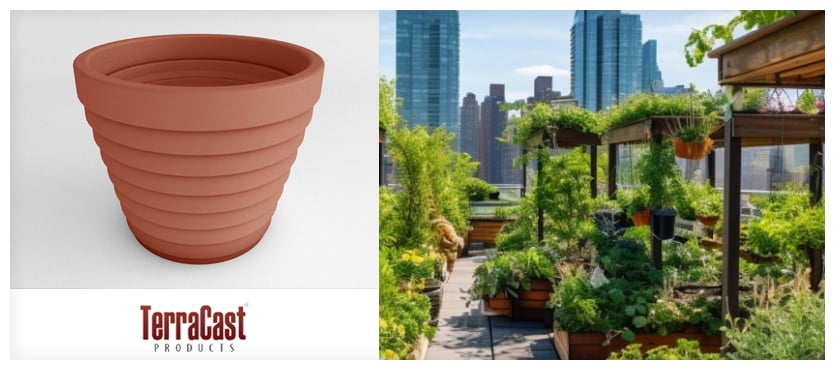Urban greening initiatives are becoming increasingly important as cities strive to create healthier, more livable environments. One of the key components of these initiatives is the use of resin planters, which offer a versatile and durable solution for incorporating greenery into urban landscapes. Resin planters can impact community well-being and contribute to the success of your urban greening projects.
The Importance of Urban Greening
Urban greening refers to the integration of green spaces, such as parks, gardens, and green roofs, into city environments. These spaces provide numerous benefits, including:
- Improved Air Quality: Plants absorb pollutants and produce oxygen, enhancing the air quality in urban areas.
- Temperature Regulation: Green spaces help mitigate the urban heat island effect by providing shade and cooling through evapotranspiration.
- Enhanced Biodiversity: Urban greening supports diverse ecosystems by providing habitats for various plant and animal species.
- Mental and Physical Health: Access to green spaces encourages physical activity, reduces stress, and promotes overall well-being.
- Social Cohesion: Green spaces serve as communal areas where people can gather, fostering a sense of community and social interaction.
The Role of Resin Planters in Urban Greening
Resin planters are a practical and effective tool for urban greening initiatives. They offer several advantages over traditional materials like concrete, ceramic, and metal, making them ideal for various applications in city environments. They are known for their durability and long lifespan. They are resistant to cracking, fading, and weathering, which means they can withstand harsh environmental conditions such as extreme temperatures, UV exposure, and heavy rainfall. This durability ensures that resin planters maintain their structural integrity and appearance over time, reducing the need for frequent replacements.
Compared to traditional planters made from concrete or ceramic, resin planters are significantly lighter. This makes them easier to transport, install, and reposition, which is particularly beneficial for urban greening projects that require flexibility and adaptability. The lightweight nature of resin planters also reduces the carbon footprint associated with transportation and installation.
Resin planters require minimal maintenance, as they do not rust, rot, or corrode. They are resistant to pests and diseases, which means fewer chemical treatments are needed. Additionally, resin planters are easy to clean and do not require painting or sealing, further reducing maintenance costs and efforts.
Resin planters are available in a wide range of shapes, sizes, colors, and finishes, allowing for creative and customized landscaping designs. Whether it’s a rooftop garden, a community park, or a bustling streetscape, resin planters can be tailored to fit any aesthetic vision. This versatility enables urban planners to create visually appealing green spaces that enhance the overall look and feel of the city.
Impact on Community Well-Being
The incorporation of resin planters into urban greening initiatives has a profound impact on community well-being. Here are some of the key benefits:
Mental and Physical Health Benefits: Access to green spaces has been shown to improve mental and physical health. Being surrounded by greenery reduces stress, anxiety, and depression, while encouraging physical activity such as walking, jogging, and gardening. Resin planters make it easier to integrate green spaces into urban areas, providing more opportunities for residents to enjoy these health benefits.
Social Cohesion and Community Engagement: Green spaces created with resin planters serve as communal areas where people can gather, interact, and build relationships. These spaces can host community events, outdoor classes, and recreational activities, fostering a sense of community and social cohesion. The presence of well-maintained green areas encourages people to spend more time outdoors and engage with their neighbors.
Environmental Education and Awareness: Urban greening projects that utilize resin planters can serve as educational tools, raising awareness about the importance of environmental sustainability. Schools, community centers, and local organizations can use these green spaces to teach residents about plant care, biodiversity, and the benefits of green infrastructure. This education can inspire more people to participate in urban greening efforts and adopt eco-friendly practices.
Economic Benefits: Attractive green spaces can boost local economies by increasing property values, attracting tourists, and encouraging business investments. Resin planters contribute to the creation of visually appealing environments that draw people in and enhance the overall economic vitality of urban areas.
Implementing Resin Planters in Urban Greening Initiatives
To maximize the benefits of resin planters in urban greening projects, it’s important to consider the following strategies:
Strategic Placement: Identify key areas in the city where resin planters can have the most impact. This includes high-traffic zones, neglected spaces, and areas with limited green cover. Strategic placement ensures that the benefits of urban greening are distributed equitably throughout the community.
Diverse Plant Selection: Choose a variety of plants that thrive in the local climate and contribute to biodiversity. Incorporate a mix of ornamental flowers, shrubs, and edible plants to create diverse and functional green spaces. Resin planters’ versatility makes it easy to accommodate different types of vegetation.
Community Involvement: Engage the community in the planning and implementation of urban greening projects. Involving residents in the selection of plants, design of green spaces, and maintenance activities fosters a sense of ownership and pride. Community involvement also ensures that the green spaces meet the needs and preferences of the local population.
Long-Term Maintenance: Develop a maintenance plan to ensure the longevity and health of the green spaces created with resin planters. This includes regular watering, pruning, and monitoring for pests and diseases. Low-maintenance resin planters simplify these tasks, making it easier to sustain urban greening efforts.
Embracing Resin Planters for Urban Greening
TerraCast® resin planters are a valuable asset in urban greening initiatives, offering durability, versatility, and low maintenance. By integrating resin planters into green spaces, cities can enhance community well-being, promote environmental sustainability, and create attractive urban landscapes. TerraCast® provides a wide range of resin products that support these goals, helping urban planners and developers build greener, healthier cities. For more information, feel free to contact us today.

